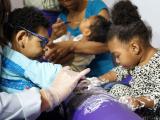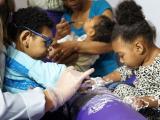Researchers based at the University of Texas Medical Branch (UTMB) today said they have created the first animal model for testing drugs and vaccines to battle Zika virus, and the genetically engineered mice have already yielded some clues about the virus's pathogenesis.
Global health officials have identified a vaccine targeted to childbearing-age women as one of the top priorities for fighting the virus, but animal models are needed for preclinical trials. The scientists reported their findings in the American Journal of Tropical Medicine and Hygiene (AJTMH).
In other developments, health officials from Chile announced the country's first sexually transmitted Zika virus case, and scientists and other stakeholders gathered at the National Institutes of Health today to discuss countermeasure development.
Mouse model in just 3 weeks
Shannan Rossi, PhD, a UTMB virologist and lead study author, said in a news release from the American Society of Tropical Medicine and Hygiene (ASTMH) that creating a mouse model typically takes several months, "but the urgency of the situation propelled us into this rapid response, and we were able to put together our results in just 3 weeks."
The ASTMH publishes AJTMH.
In the 1950s, researchers conducted animal model work for Zika virus on rhesus macaques, but not all infected animals showed signs of disease, according to the study. Attempts to develop a rodent model that could consistently show disease proved difficult.
The team injected several genetically distinct lab mice with an Asian strain of the virus from 2010, the type causing the outbreak in the Americas.
A challenge the team faced was that mice don't typically get sick after infection with Zika virus, but they found that mice genetically altered to have impaired immune response developed clinical disease after experimental infection. Young mice were highly susceptible to infection, becoming lethargic, losing weight, and dying within 6 days of infection. Older mice got sick but didn't always show symptoms, and they recovered from the disease.
Identification of where the virus was found in the mice's organs yielded several clues. Though the investigators found viral particles in most of the organ systems, levels were highest in the spleen, brain, and testes. Researchers said the results are preliminary, but they support evidence of sexual transmission and the Zika virus's effect on the nervous system.
Rossi emphasized that the mouse study doesn't prove a direct connection between the virus and microcephaly, but it points to a need for effective animal models to further study the course of the disease and how it transmits.
Scott Weaver, PhD, one of the UTMB researchers who has studied Zika virus alongside other arboviruses for several years, said the mice in the study were developed for testing drug and vaccine candidates and may not be good models for human transmission. He added that nonhuman primate models will probably be needed to answer questions about human transmission and that UTMB researchers are working on that research, which is at early stages.
Though the mouse model should be refined, it offers a springboard for in vivo screening of antivirals and vaccines, the team said in the study. It is available immediately for antiviral testing, and initial tests are already under way on an antiviral that targets dengue fever, which was developed by another UTMB scientist.
Stephen Higgs, PhD, ASTMH president, said in the release that the UTMB team's dedication and earlier work on dengue and other arboviruses helped streamline work on the Zika animal model. Lack of earlier interest in and funding for Zika virus research and the current outbreak shows how vulnerable the world is to poorly understood viruses and shows the need for smart and sustained investments in basic and applied research, he added.
Sexual transmission in Chile
Meanwhile, Chile's health ministry on Mar 26 reported the country's first sexually transmitted Zika virus case, a 46-year-old woman who got sick after having unprotected sex with her partner who had recently traveled to Haiti, the Associated Press (AP) said yesterday, citing a ministry statement.
The man was infected with the virus while in Haiti, according to the report.
The case raises the number of countries that have reported likely sexual transmission of Zika virus to six. The others are the United States, France, Italy, Argentina, and New Zealand.
Last week health officials in Saskatchewan, Canada, said they were investigating a possible sexual transmission case, and the Public Health Agency of Canada said it was waiting on lab confirmation, according to a Mar 24 CBC report.
HHS, CDC meeting updates
In other developments, experts gathered in Bethesda, Md., today for the start of a 2-day expert meeting to help speed the development of Zika virus countermeasures. The meeting, available by webinar, is hosted by US federal health agencies, including the Department of Health and Human Services (HHS) and the National Institute of Allergy and Infectious Diseases.
Today the group covered the science and epidemiology of Zika virus and its complications, reviewed HHS resources to support product development, and discussed vaccine development issues. Tomorrow stakeholders will cover diagnostics, drugs, mosquito control efforts, and HHS countermeasure priorities.
On Friday the US Centers for Disease Control and Prevention (CDC) is hosting a Zika summit at its Atlanta headquarters, targeting state and local health officials. Experts will cover the latest scientific evidence on the virus and its complications, as well as mosquito control strategies, communication practices, and steps to pinpoint preparedness gaps. The CDC will be live-streaming the event.
See also:
Mar 28 AJTMH abstract
Mar 28 ASTMH press release
Mar 27 AP story
Mar 24 CBC story
Zika countermeasure meeting webinar link
Zika countermeasure meeting agenda
Mar 4 CDC statement on Apr 1 Zika summit
CDC Zika summit live stream information





















